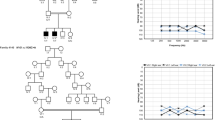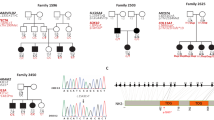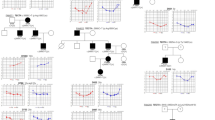Abstract
Inherited causes account for about 50% of Individuals presenting with childhood (prelingual) hearing loss, of which 70% are due to mutation in numerous single genes which impair auditory function alone (non-syndromic)1. The remainder are associated with other developmental anomalies termed syndromic deafness. Genes responsible for syndromic forms of hearing loss include the COL4A5 gene in Alport syndrome and the PAX3 and MITF genes in Waardenburg syndrome2. Pendred syndrome is an autosomal recessive disorder associated with developmental abnormalities of the cochlea, sensorineural hearing loss and diffuse thyroid enlargement (goitre)3,4. Pendred syndrome is the most common syndromal form of deafness, yet the primary defect remains unknown. We have established a panel of 12 families with two or more affected individuals and used them to search for the location of the Pendred gene by linkage analysis. We excluded localization to four previously mapped nonsyndromic deafness loci but obtained conclusive evidence for linkage of the Pendred syndrome gene to microsatellite markers on chromosome 7q31 (D7S496 Zmax 7.32, Qmax = 0). This region contains a gene, DFNBL, for autosomal recessive non-syndromic sensorineural hearing loss. Multipoint analysis indicates that DFNB4 and Pendred syndrome co-localize to the same 5.5 centiMorgan (cM) interval flanked by D7S501 and D7S523. These data raise the possibility that Pendred syndrome is either allelic with DFNB4 or may represent an inherited contiguous gene disorder, not clinically manifest in the heterozygote.
This is a preview of subscription content, access via your institution
Access options
Subscribe to this journal
Receive 12 print issues and online access
$209.00 per year
only $17.42 per issue
Buy this article
- Purchase on Springer Link
- Instant access to full article PDF
Prices may be subject to local taxes which are calculated during checkout
Similar content being viewed by others
References
Reardon, W. Genetic deafness. J. Med. Genet. 29, 521–526 (1992).
Gorlin, R.J., Toriello, H.V. & Cohen, M.M., Genetic deafness and its syndromes. 2nd ed. (Oxford University Press, 1995).
Pendred, V. Deaf-mutism and goiter. Lancet 2, 523 (1896).
Brain, W.R. Heredity in simple goiter. Quart. J. Med. 20, 303–331 (1927).
Reardon, W. & Trembath, R.C. Pendred syndrome. in Genetics and Hearing Impairment (eds Stephens, S. G.D., Read, A.P. & Martini, A. (Whurr Publications, London, in the press).
Fraser, G.R., Morgans, M.E. & Trotter, W.R. The syndrome of sporadic goitre and congenital deafness. Quart. J. Med. 29, 279–295 (1960).
Fraser, G.R. Association of congenital deafness with goiter (Pendred's syndrome); a study of 207 families. Ann. Hum. Genet 28, 201–249 (1965).
Billerbeck, A.E.C., Cavaliere, H., Goldberg, A.C., Kalil, J. & Medeiros-Neto, G. Clinical and molecular genetics studies in pendred syndrome. Thyroid 4, 279–284 (1994).
Gausden, E. et al. Thyroid peroxidase: evidence for disease gene exclusion in Pendred syndrome. Clin. Endocr. (in the press).
Guilford, P. et al. A non-syndromic form of neurosensory, recessive deafness maps to the pericentromeric region of chromosome 13q. Nature Genet. 6, 24–28 (1994).
Guilford, R. et al. A human gene responsible for neurosensory, non-syndromic, recessive deafnessis a candidate homologue of the mouse sh1 gene. Hum. Mol. Genet. 3, 989–993 (1994).
Friedman, T.B. et al. A gene for congenital, recessive deafness DFNB3 maps to the pericentric region of chromosome 17. Nature Genet. 9, 86–91 (1995).
Fukushima, K. et al. Consanguineous nuclear families used to identify a new locus for recessive non-syndromic hearing loss on 14q. Hum. Mol. Genet. 4, 1643–1648 (1995).
Baldwin, C.T. et al. Linkage of congenital, recessive deafness (DFNB4) to chromosome 7q31 and evidence for genetic heterogeneity in the Middle Eastern Druze population. Hum. Mol. Genet. 4, 1637–1642 (1995).
Jain, R.K. et al. A human recessive neurosensory non-syndromic hearing impairment locus is a potemetial homologue of the murine deafness (DN) locus. Hum. Mol. Genet 4, 2391–2394 (1995).
Chaib, H. et al. A gene responsible for a sensorineual nonsyndromic recessive deafnes maps to 2p22–23. Hum. Mol. Genet. 5, 155–158 (1996).
Veske, A. et al. Autosomal recessive non-syndromic deafness locus (DFNB8) maps on chromosome 21q22 in a large consanguineous kindred from Pakistan. Hum. Mol. Genet 5, 165–168 (1996).
Lander, E.S. & Botstein, D. Homozygosity mapping: a way to map human recessive traits with the DNA of inbred children. Science 236, 1567–1570 (1987).
Reed, R.W. et al. Chromosome-specific microsatellite sets for fluorescence-based, semi-automated genome mapping. Nature Genet. 7, 390–395 (1994).
Cremers, F.RM. et al. Physical fine mapping of the choroideraemia locus using Xq21 deletions associated with complex syndromes. Genomics 4, 41–46 (1989).
Lathrop, G.M., Lalouel, J.M., Julier, C. & Ott, J. Strategies for multilocus linkage analysis in humans. Proc. Natl. Acad. Sci. USA 81, 3443–3446 (1984).
Terwilliger, J.D. A powerful likelihood method for the analysis of linkage disequelibrium between trait loci and one or more polymorphic marker loci. Am. J. Hum. Genet 56, 777–787 (1995).
Ott, J. Analysis of Human Genetic Linkage 2nd edn. 203–216 (John Hopkins University Press, Baltimore, 1991).
Guapay, G. et al. The 1993–94 Genethon human genetic linkage map. Nature Genet. 7, 246–339 (1994).
Author information
Authors and Affiliations
Rights and permissions
About this article
Cite this article
Coyle, B., Coffey, R., Armour, J. et al. Pendred syndrome (goitre and sensorineural hearing loss) maps to chromosome 7 in the region containing the nonsyndromic deafness gene DFNB4. Nat Genet 12, 421–423 (1996). https://doi.org/10.1038/ng0496-421
Received:
Accepted:
Issue Date:
DOI: https://doi.org/10.1038/ng0496-421
This article is cited by
-
The incidence of enlarged vestibular aqueduct among hearing-impaired children: hospital-based tertiary care referral center
The Egyptian Journal of Otolaryngology (2022)
-
Exome sequencing identifies SLC26A4, GJB2, SCARB2 and DUOX2 mutations in 2 siblings with Pendred syndrome in a Malaysian family
Orphanet Journal of Rare Diseases (2017)



